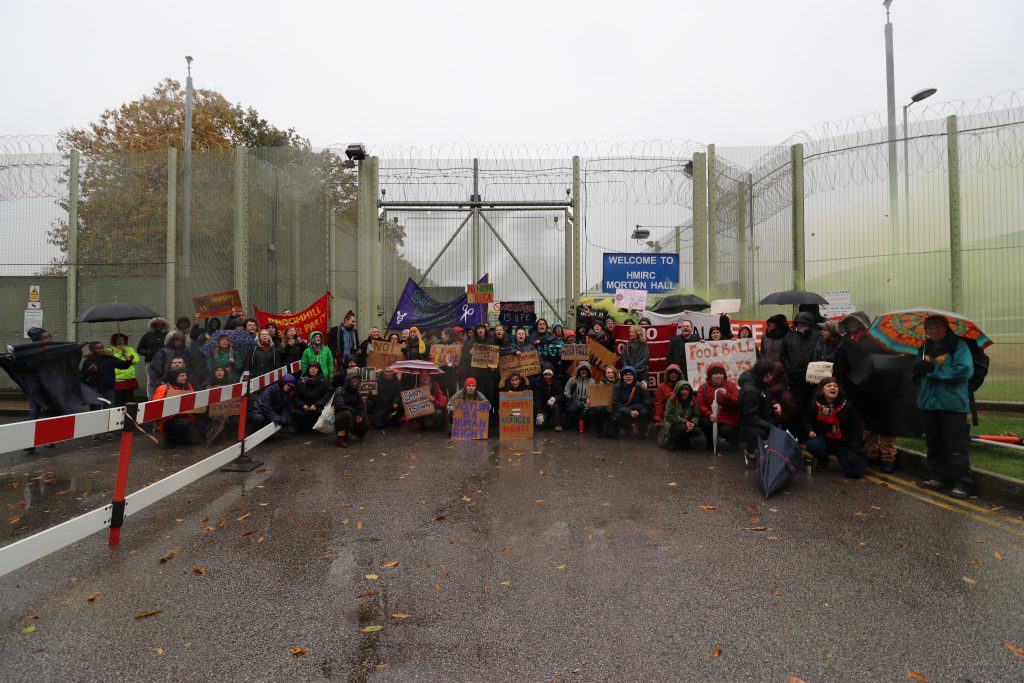
No reading or discussion prepared me for how it felt to be at Morton Hall. It feels remote. I’m sure it’s deliberate that it feels a long way from friends and family. It also feels a long way from policymakers.
Hamish, Manchester
On Saturday 26th October, around 100 people from Nottingham, Lincoln, Sheffield, Leeds, Manchester, Oxford and London gathered outside the high, razor wire-topped walls of Morton Hall, an ex-prison in rural Lincolnshire. Morton Hall is officially called an ‘immigration removal centre’ by the UK government. But make no mistake, it is a prison. It is the only detention centre in the UK run by Her Majesty’s Prison Service, which means if the government wanted to close it down, they could do so tomorrow. However, it remains open, and up to 392 migrants are held there at any one time.
Morton Hall is a deadly place to be. Several people have died whilst detained there. Just a few days ago, an inquiry into the death of Carlington Spencer, aka ‘Jammy’, in 2017 found multiple failings contributed to his death. Just weeks earlier, an inquiry into Bai Bai Ahmed Kabia’s death there found similar negligence in his care.
Campaigners such as South Yorkshire Migration and Asylum Action Group, and Sheffield Student Action for Refugees, have been organising protests at Morton Hall for six years, and they’ve been happening there for ten.
We asked some of the attendees at this most recent protest – the biggest so far – to reflect on the day. Plans are underway for the next protest in Spring 2020, and we hope that these words and photos will encourage you to join us.
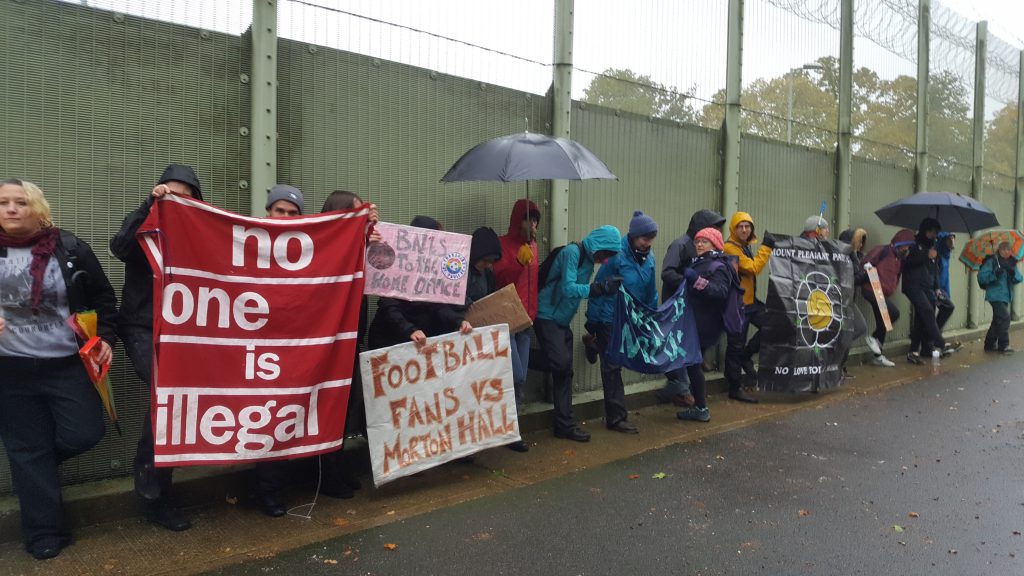
Natasha came with Sheffield STAR, who work to support refugees in Sheffield. She felt taking part in the protest was important because she “felt a great sense of unease of not acting when the people detained have no freedom or voice given to them to do so.” She described the solidarity on the day – which was very very rainy – as being really powerful,
It was incredible to see people brought together for a common cause and a lot of camaraderie – especially people holding each other’s umbrellas while they took turns smashing at the fences and passing warm drinks to people who’d lost their voices from chanting so loud to try reach those inside the caged walls. There was also a lot of anger inside me knowing our government could be so inhumane in its treatment of people who, a lot of the time have been through hell to get here.
Natasha, Sheffield
For people who’d previously been locked in Morton Hall, coming back to protest brings mixed feelings. For Victor, this was the first time he’d been there since he was released from detention in February this year. The ongoing detention of others means he’s become more active now in speaking out against detention as a whole.
The whole experience of going back to Morton Hall was one of ambivalence for me. I was detained and released but there are some of my fellow detainees still there whose lives are at a standstill never knowing when they will be released.
Victor, Sheffield
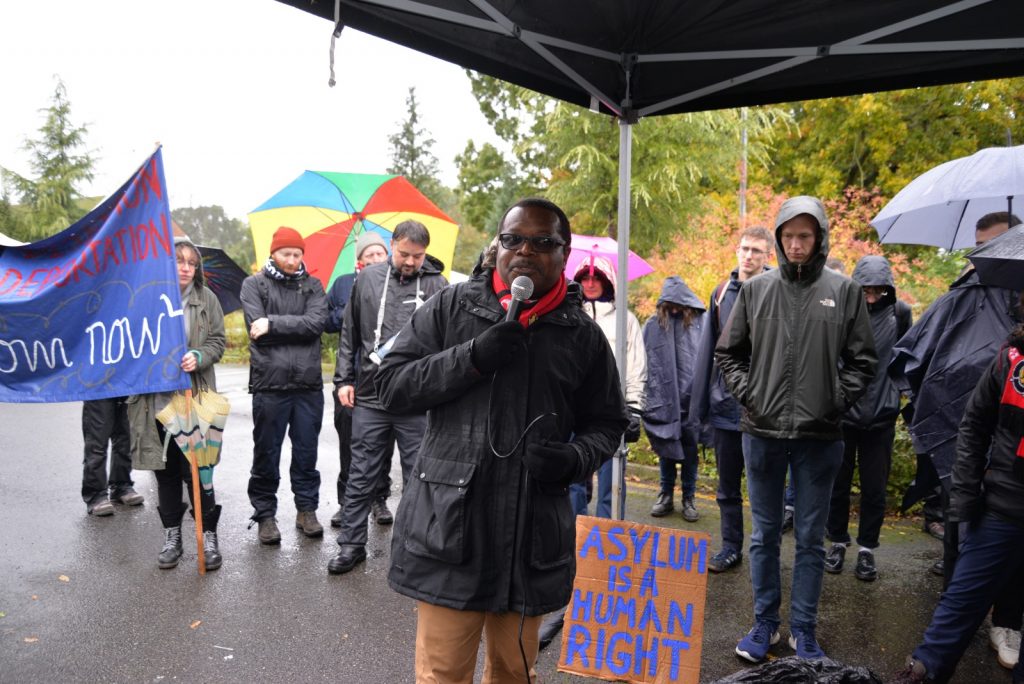
Several people who had experienced detention themselves were unable to come, and their words were read out by those who could. Protesters found this very powerful and mentioned how so many might find coming to the protest too traumatic.
One of the organisers read out a message from a woman, a refugee, who did not attend. She described those inside as angels that needed to be raised up and allowed to flourish… “to stop punishing strangers who run to you for help, to stop locking up future scientists and burying talent in its infancy”…That passage stays with me, the humanity of it. I wish more people could understand, her voice echoes so many tragic stories I’ve heard but still holds hope and that makes this fight worthwhile.
Natasha, Sheffield
A group of campaigners came from Manchester, from These Walls Must Fall, and Manchester Momentum. Hamish from Manchester talked about his first impressions,
Although remote, as soon as we arrived, it also felt deliberately imposing. The height of the walls which block views in and out. The fences extending the walls higher. The barbed wire. The size of the reinforcing bolts. Police at the entrance.
Hamish, Manchester
Organiser, Phillis from South Yorkshire Migration and Asylum Action Group (SYMAAG) facilitated a range of speakers who spoke passionately about the injustice of detention and the cases of people who have died in Morton Hall. SYMAAG reflected that the protest was the biggest ever, and that it was great to have people from all over the country as well as locals from Lincoln and Collingham.
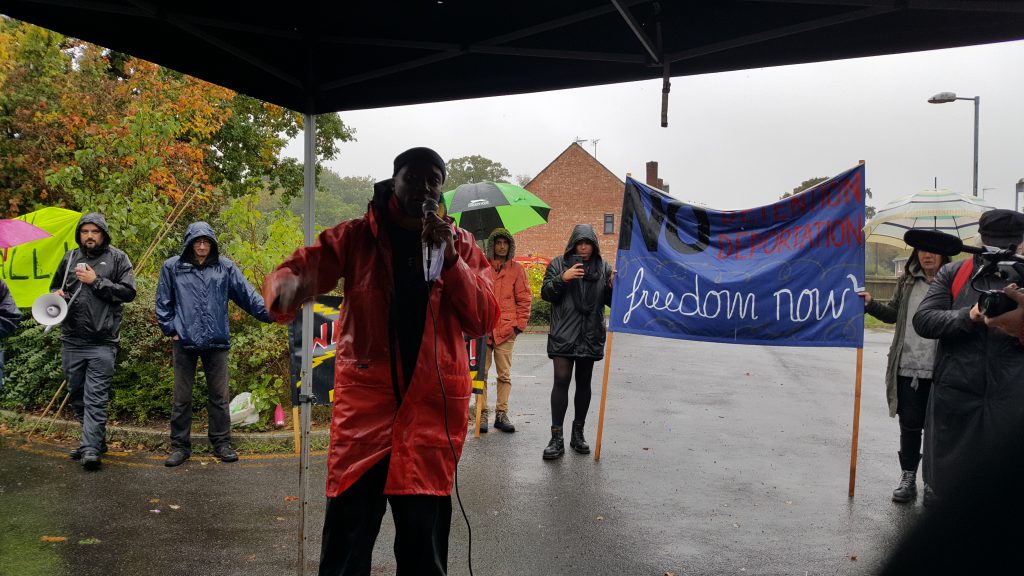
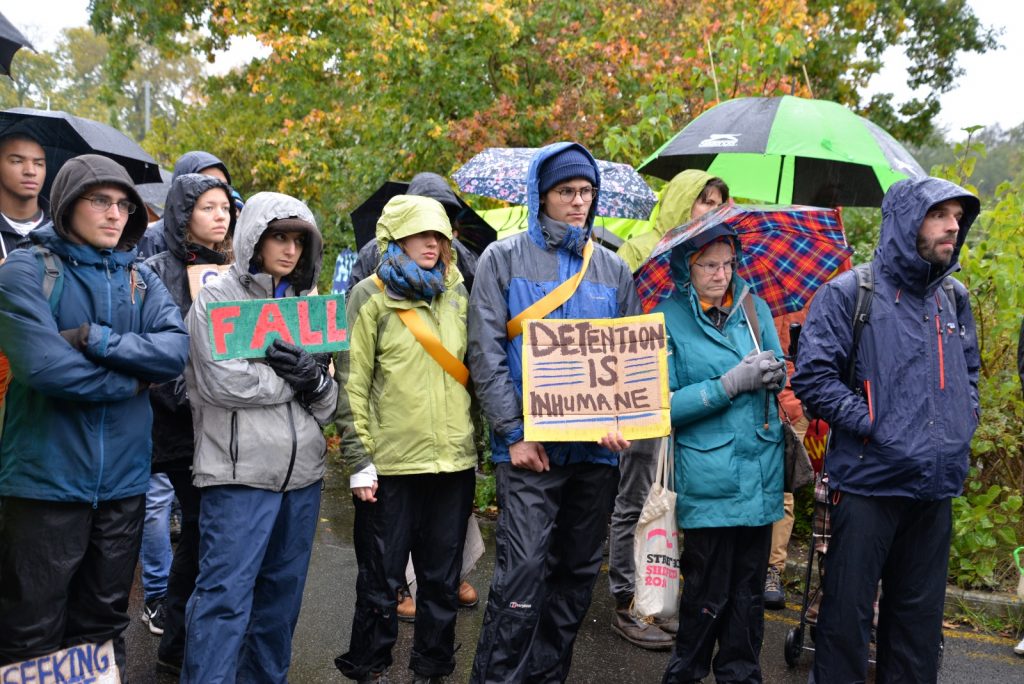
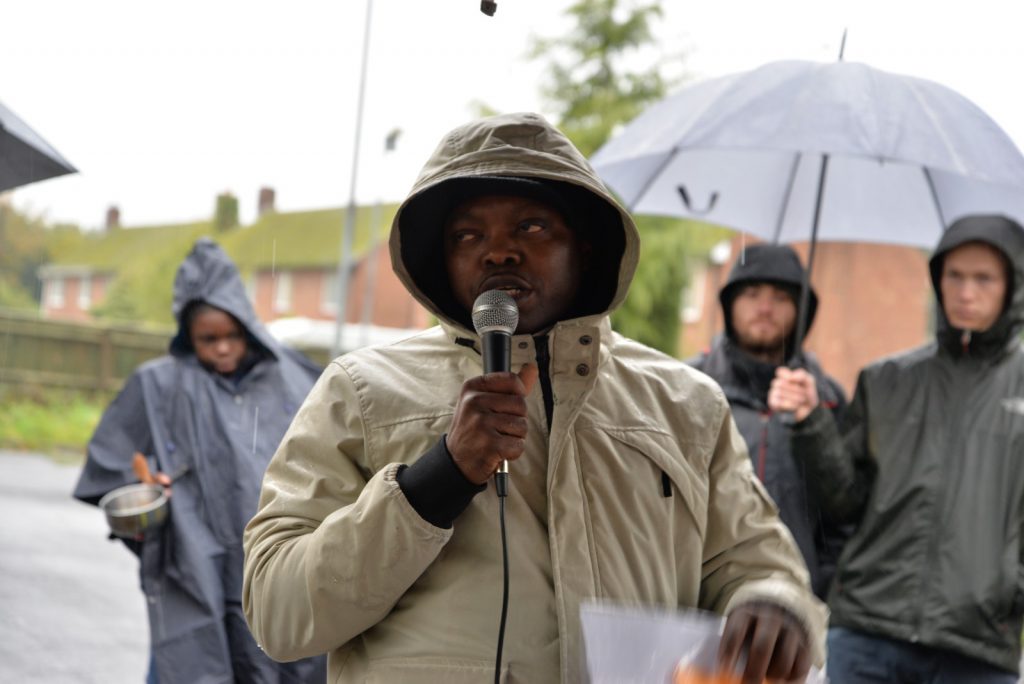
Some These Walls Must Fall campaigners from Sheffield, Liverpool and Manchester were not able to come with us, but sent their words to share. Some shared haunting stories of suicide attempts, trauma, and pain in Morton Hall and Yarl’s Wood. Another, Hannah, had a word of caution for our society,
Stop punishing strangers who run to you for help. Most of the time they come in as destitute, as vulnerable, as an outcasts. If we treat them right, welcome them and make them feel comfortable, in no time, we begin to see their wings and their shining swords. It’s high time we know that this method of detention is not helping anyone. Close down the detention houses. Turn them to a place where people go to connect to the goldmine deposited inside of them. Turn them to where people go to discover or rediscover themselves. Turn them to where people go in as dwarfs and come out as giants.
Hannah, Sheffield
Those that could attend spoke of their sense of deep privilege at being able to do so, without fear, due to their own citizenship.
Standing in solidarity with those held inside Morton Hall, I felt furious anger and frustration at the gross injustice symbolised by the walls.
As words were spoken, particularly words spoken on behalf of people who could not attend, hope began to sit alongside anger. In the face of such injustice, it feels important to trust in solidarity and our capacity to change things by collectively applying pressure against violent structures and those who defend them.
Hamish, Manchester
As speeches drew to a close and anger and emotion was rising, the atmosphere felt strengthened by the oppressive weather and palpable sense of anger. Protesters kicked the fences to let people inside know that they were there, and that we are watching. It was important to be there to shed light on the injustice. And it was also important for so many who had never been to a detention centre before to see the reality of it, which we hope will spur them into further activity to end detention back in their communities, where people are taken away and locked up every week.
There was some catharsis collectively kicking them, making noise, to announce our arrival.
Hamish, Manchester
There is also something deeply reassuring about spending time with people who share your sense of injustice – perhaps especially poignantly so in the shadow of that injustice. People from different cities gathered in the rain to listen and shout, to meet each other and bang on the walls.
Attendees also drew connections between Morton Hall and detention and the wider hostile environment. Just days before this there was tragic news of 39 Vietnamese migrants who died in a lorry. Sheffield STAR shared their thoughts on the connection with this tragedy on their Facebook,
Stephanie, from Lincoln, is part of a group of local workers and residents beginning to shine a light on what’s happening on their doorstep. She’d found out about what was happening at Morton Hall alongside learning about Manus Island and Port Moresby in Papua New Guinea, where migrants are also detained.
The poet Emily Dickinson was famously confined to her room with debilitating sickness for much of her life. She lived the world through words, and once wrote, ‘Hope is the thing with feathers’, a line that conjures flight and freedom. Her words soared over the walls of her illness. Today I read that the poet, filmmaker and long term detainee, Behrouz Boochani, has landed in New Zealand and feels himself a free man after six years of arbitrary detention on Manus Island and Port Moresby. Dickinson’s poem came to mind at once. So did the metal fences of HMIRC Morton Hall. And I remembered the sound of boots banging the metal fence to alert the detainees inside that people were outside, making a racket on their behalf, to drown out the silence. Perhaps the boots on the fence would raise a clamour of birds above our heads, the things with feathers rising in judgement on injustice.
Stephanie, Lincoln
Why are so many men and women detained behind fences and walls in the early 21st century? What has happened to the relationship between justice, imprisonment, restitution, and civil society that we as a nation and indeed as a world are able with no compunction to shoot down the bird with feathers, over and over again? Hope is a thing with feathers, that perches in the soul. It’s time we got our souls back.
Stephanie, Lincoln
Since returning, campaigners have been holding debrief and reflection sessions and are already planning their next moves. But they have also been discussing other ways of campaigning to end detention, as “demonstrating is not everything, it’s only the start and it certainly isn’t always the right thing for some. We must do more, and we must look out for each other and spread the message of the government’s inhumane treatment far and wide.”
Watch this space for future activity, and sign up for updates from These Walls Must Fall here.

thank you for caring about the uncared for – exemplary.
Thank you guys for caring for the uncared for. Much love and appreciation.